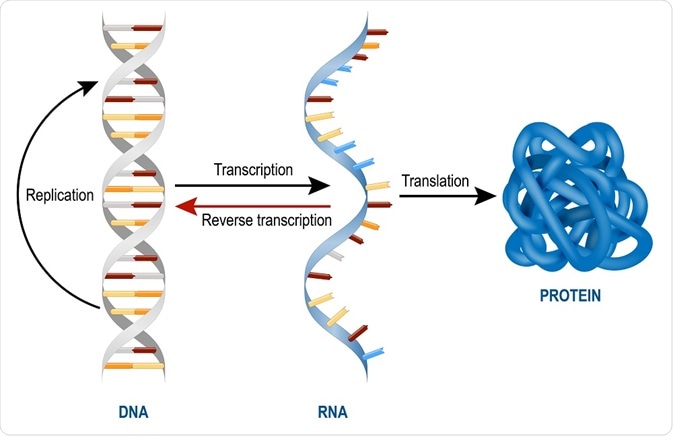RNA or ribonucleic acid is a polymer of nucleotides that is made up of a ribose sugar, a phosphate, and bases such as adenine, guanine, cytosine, and uracil. It plays a crucial role in gene expression by acting as the intermediate between the genetic information encoded by DNA and proteins.
 Designua | Shutterstock
Designua | Shutterstock
RNA has a structure very similar to that of DNA. The key difference in RNA structure is that the ribose sugar in RNA possesses a hydroxyl (-OH) group that is absent in DNA.
Types of RNA
In both prokaryotes and eukaryotes, there are three main types of RNA – messenger RNA (mRNA), ribosomal RNA (rRNA), and transfer RNA (tRNA). These 3 types of RNA are discussed below.
Messenger RNA (mRNA)
mRNA accounts for just 5% of the total RNA in the cell. mRNA is the most heterogeneous of the 3 types of RNA in terms of both base sequence and size. It carries complementary genetic code copied, from DNA during transcription, in the form of triplets of nucleotides called codons.
Each codon specifies a particular amino acid, though one amino acid may be coded for by many different codons. Although there are 64 possible codons or triplet bases in the genetic code, only 20 of them represent amino acids. There are also 3 stop codons, which indicate that ribosomes should cease protein generation by translation.
As part of post-transcriptional processing in eukaryotes, the 5’ end of mRNA is capped with a guanosine triphosphate nucleotide, which helps in mRNA recognition during translation or protein synthesis. Similarly, the 3’ end of an mRNA has a poly-A tail or multiple adenylate residues added to it, which prevents enzymatic degradation of mRNA. Both the 5’ and 3’ end of an mRNA imparts stability to the mRNA.
Ribosomal RNA (rRNA)
rRNAs are found in the ribosomes and account for 80% of the total RNA present in the cell. Ribosomes are composed of a large subunit called the 50S and a small subunit called the 30S, each of which is made up of its own specific rRNA molecules. Different rRNAs present in the ribosomes include small rRNAs and large rRNAs, which belong to the small and large subunits of the ribosome, respectively.
rRNAs combine with proteins and enzymes in the cytoplasm to form ribosomes, which act as the site of protein synthesis. These complex structures travel along the mRNA molecule during translation and facilitate the assembly of amino acids to form a polypeptide chain. They interact with tRNAs and other molecules that are crucial to protein synthesis.
In bacteria, the small and large rRNAs contain about 1500 and 3000 nucleotides, respectively, whereas in humans, they have about 1800 and 5000 nucleotides, respectively. However, the structure and function of ribosomes is largely similar across all species.
Transfer RNA (tRNA)
tRNA is the smallest of the 3 types of RNA, possessing around 75-95 nucleotides. tRNAs are an essential component of translation, where their main function is the transfer of amino acids during protein synthesis. Therefore, they are called transfer RNAs.
Each of the 20 amino acids has a specific tRNA that binds with it and transfers it to the growing polypeptide chain. tRNAs also act as adapters in the translation of the genetic sequence of mRNA into proteins. Thus, they are also called adapter molecules.
tRNAs have a cloverleaf structure which is stabilized by strong hydrogen bonds between the nucleotides. They normally contain some unusual bases in addition to the usual 4, which are formed by methylation of the usual bases. Methyl guanine and methylcytosine are two examples of methylated bases.
What is RNA | Genetics | Biology | FuseSchool
Other types of RNA
Beyond the primary role of RNA in protein synthesis, several varieties of RNA exist that are involved in post-transcriptional modification, DNA replication, and gene regulation. Some forms of RNA are only found in particular forms of life, such as in eukaryotes or bacteria.
Small nuclear RNA (snRNA)
snRNA is involved in the processing of pre-messenger RNA (pre-mRNA) into mature mRNA. They are very short, with an average length of only 150 nucleotides.
Regulatory RNAs
A number of types of RNA are involved in regulation of gene expression, including micro RNA (miRNA), small interfering RNA (siRNA) and antisense RNA (aRNA).
miRNA (21-22 nt) is found in eukaryotes, and acts through RNA interference (RNAi). miRNA can break down mRNA that it is complementary to, with the aid of enzymes. This can block the mRNA from being translated, or accelerate its degradation.
siRNA (20-25 nt) are often produced by breakdown of viral RNA, though there are also endogenous sources of siRNAs. They act similarly to miRNA. An mRNA may contain regulatory elements itself, such as riboswitches, in the 5' untranslated region or 3' untranslated region; these cis-regulatory elements regulate the activity of that mRNA.
Transfer-messenger RNA (tmRNA)
Found in many bacteria and plastids. tmRNA tag the proteins encoded by mRNAs that lack stop codons for degradation, and prevents the ribosome from stalling due to the missing stop codon.
Ribozymes (RNA enzymes)
RNAs are now known to adopt complex tertiary structures and act as biological catalysts. Such RNA enzymes are known as ribozymes, and they exhibit many of the features of a classical enzyme, such as an active site, a binding site for a substrate and a binding site for a cofactor, such as a metal ion.
One of the first ribozymes to be discovered was RNase P, a ribonuclease that is involved in generating tRNA molecules from larger, precursor RNAs. RNase P is composed of both RNA and protein; however, the RNA moiety alone is the catalyst.
Double-stranded RNA (dsRNA)
This type of RNA has two strands bound together, as with double-stranded DNA. dsRNA forms the genetic material of some viruses.
Further Reading
Last Updated: Apr 7, 2023